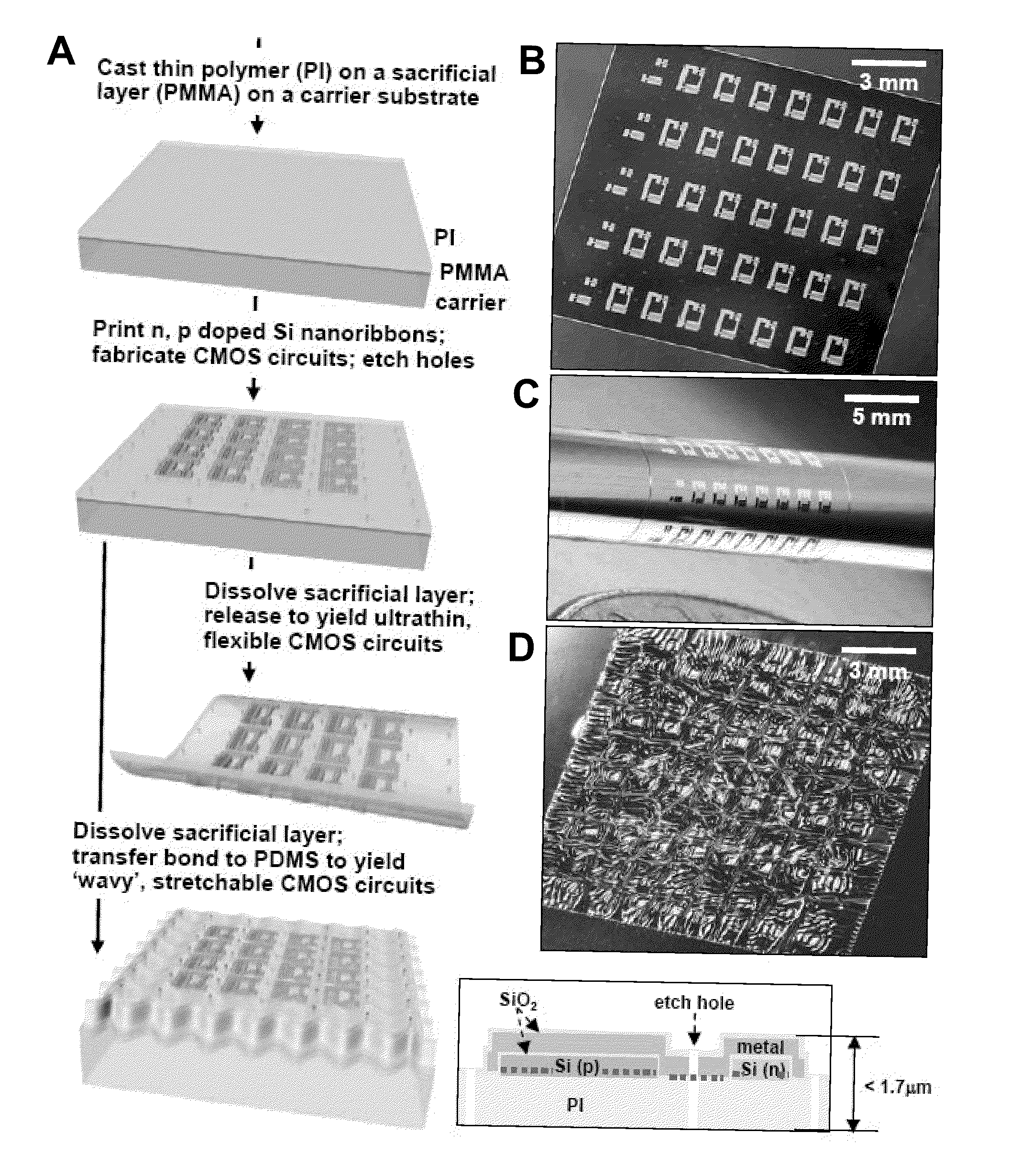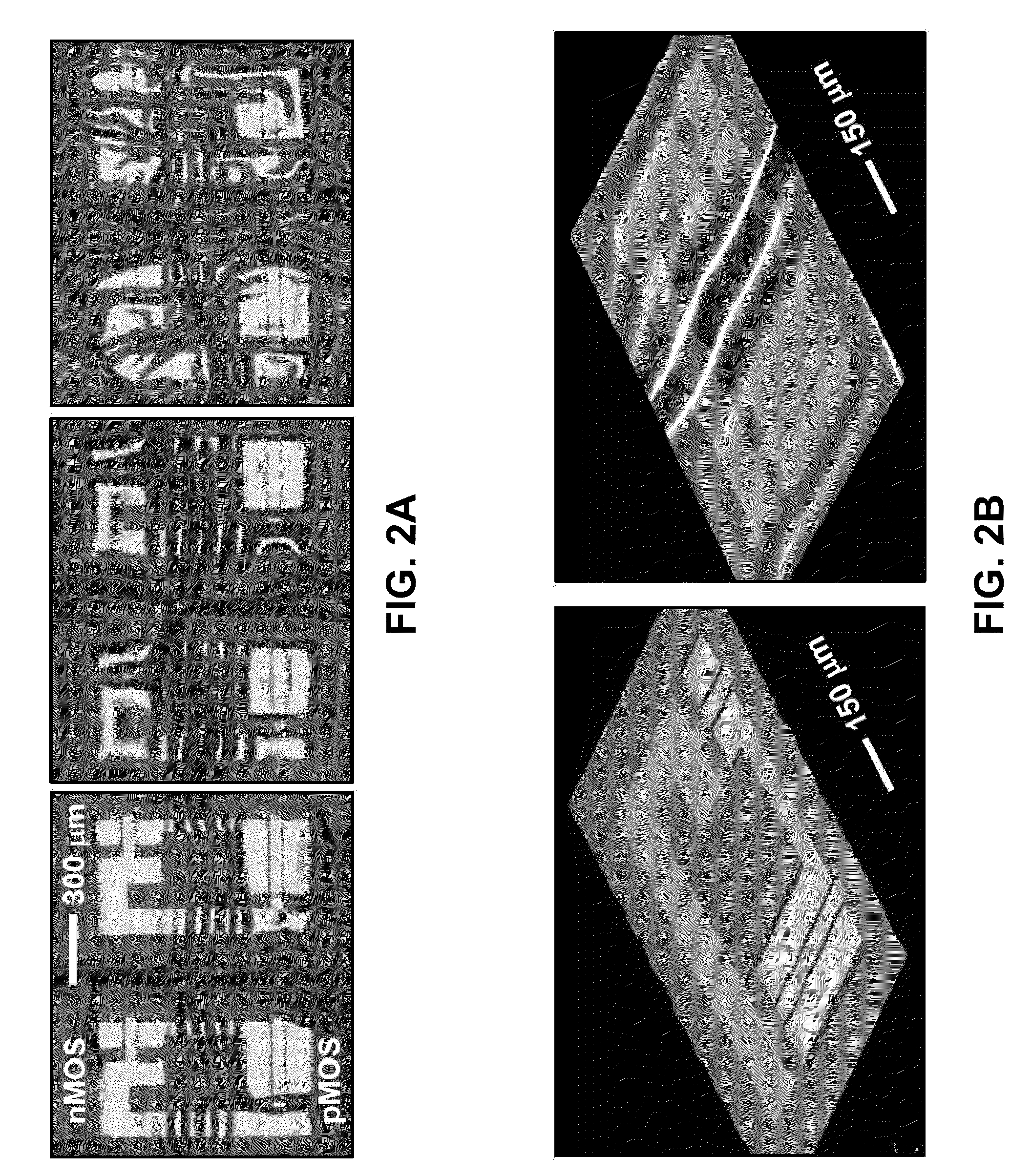Stretchable and foldable electronic devices
a technology of electronic devices and foldable parts, applied in the direction of dielectric characteristics, circuit bendability/stretchability, coatings, etc., can solve the problems inability to withstand the force of mechanical force, etc., to achieve the effect of facilitating design and manufacture, reducing or eliminating the influence of mechanical strain on the performance of electronic devices
- Summary
- Abstract
- Description
- Claims
- Application Information
AI Technical Summary
Benefits of technology
Problems solved by technology
Method used
Image
Examples
example 1
Stretchable and Foldable Silicon Integrated Circuits
[0165]Disclosed herein are approaches to access high performance, stretchable and foldable integrated circuits (ICs). The systems integrate inorganic electronic materials, including aligned arrays of nanoribbons of single crystalline silicon, with ultrathin plastic and elastomeric substrates. The designs combine multilayer neutral mechanical plane layouts and ‘wavy’ structural configurations in silicon complementary logic gates, ring oscillators and differential amplifiers. Three dimensional analytical and computational modeling of the mechanics of deformations in these ICs, together with circuit simulations, illuminate aspects that underlie the measured behaviors. The strategies represent general and scalable routes to high performance, foldable and stretchable optoelectronic devices that can incorporate established, high performance inorganic electronic materials whose fragile, brittle mechanical properties would otherwise preclu...
example 2
A Hemispherical Electronic Eve Camera Based on Compressible Silicon Optoelectronics
[0218]The human eye represents a remarkable imaging device, with many attractive design features.1,2 Prominent among these is a hemispherical detector geometry, similar to that found in many other biological systems, that enables wide field of view and low aberrations with simple, few component, imaging optics. This type of configuration is extremely difficult to achieve using established optoelectronics technologies, due to the intrinsically planar nature of the patterning, deposition, etching, materials growth and doping methods that exist for fabricating such systems. This example provides processes and related systems that avoid these apparent limitations. The devices and processes are used to yield high performance, hemispherical electronic eye cameras based on single crystalline silicon technology. The approach uses wafer-scale optoelectronics formed in unusual, two dimensionally compressible co...
example 3
CMOS Integrated Circuits with Monolithically Integrated Stretchable Wavy Interconnects
[0302]Stretchable CMOS circuits comprising ultrathin active devices mechanically and electrically connected by narrow metal lines and polymer bridging structures are presented. This layout, together with designs that locate the neutral mechanical plane near the critical circuit layers yields strain independent electrical performance and realistic paths to circuit integration. Mechanical and electrical modeling and experimental characterization reveal the underlying physics of these systems.
[0303]Stretchable electronics is emerging as a technology that could be valuable for various applications, such as conformal personal or structural health monitors and hemispherical detector arrays. Such devices cannot be accomplished with conventional wafer based circuits or even with more recent systems that offer simple mechanical bendability. Presently, two approaches exist for achieving stretchability via th...
PUM
| Property | Measurement | Unit |
|---|---|---|
| temperatures | aaaaa | aaaaa |
| fracture strains | aaaaa | aaaaa |
| distance | aaaaa | aaaaa |
Abstract
Description
Claims
Application Information
 Login to View More
Login to View More - R&D
- Intellectual Property
- Life Sciences
- Materials
- Tech Scout
- Unparalleled Data Quality
- Higher Quality Content
- 60% Fewer Hallucinations
Browse by: Latest US Patents, China's latest patents, Technical Efficacy Thesaurus, Application Domain, Technology Topic, Popular Technical Reports.
© 2025 PatSnap. All rights reserved.Legal|Privacy policy|Modern Slavery Act Transparency Statement|Sitemap|About US| Contact US: help@patsnap.com



